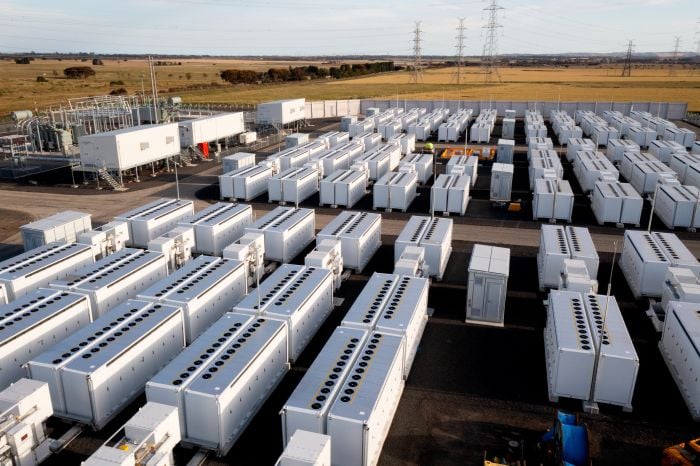
A capacity mechanism for Australia’s National Electricity Market (NEM) needs to catalyse urgently needed investment in renewable energy and energy storage, trade groups have said.
A proposal to add a capacity mechanism to Australia’s National Electricity Market (NEM) has been published by the country’s Energy Security Board (ESB) this week.
Enjoy 12 months of exclusive analysis
- Regular insight and analysis of the industry’s biggest developments
- In-depth interviews with the industry’s leading figures
- Annual digital subscription to the PV Tech Power journal
- Discounts on Solar Media’s portfolio of events, in-person and virtual
It would mark the first time a capacity market-style framework for making sure electricity supply matches demand has been introduced to the NEM.
ESB has made its draft proposal available to view and is now seeking stakeholder feedback on the high-level design paper, which ESB chair Anna Collyer said aims to make capacity available when it’s needed and avoid a “disorderly transition” away from fossil fuel generation.
“It will provide a more direct and certain way to ensure we have the right amount of capacity and right mix of capacity available when and where we need it,” Collyer said.
The Board is now seeking stakeholder submissions and wants to deliver a “considered and collaborative design that is fit for the future”, the chair added. Respondents have until 25 July to respond and ESB anticipated that it will submit a final proposal to ministers early next year.
Australia’s Clean Energy Council and Smart Energy Council, two trade associations that represent dozens of stakeholder organisations between them, warned that any capacity mechanism introduced needed to avoid the trap of extending reliance on fossil fuels.
Renewables and storage ‘could make Australia an energy superpower’
With the country currently in an energy crisis largely caused by unplanned outages at over 3,000MW of coal plants and planned maintenance at other thermal generation sites as it experiences an early onset of cold winter weather, it is critical that new policy mechanisms instead deliver rapid investment in renewable generation, energy storage and transmission, the Clean Energy Council (CEC) said.
That investment is the only way to bring energy prices down and prevent a similar situation happening again, CEC argued, while any moves to subsidise existing coal power plants and prolong the lifetime of fossil fuel generators would put Australia in an uphill battle to meet climate targets.
It could also delay investment in renewable energy and energy storage, CEC said.
Meanwhile, John Grimes, chief executive at the Smart Energy Council, said a capacity mechanism focused on zero emissions generation should be among the options considered to keep the lights on, but said investment in renewables and storage should in any case be the most urgent priority for Australia’s energy sector.
Grimes stressed further the importance of energy storage, which in combination with renewables could make Australia a clean energy “superpower”.
“Australia is in a unique position being at the forefront of the renewables revolution but there’s not yet sufficient investor confidence to support the energy storage we need to complement wind and solar,” Grimes said.
The Smart Energy Council is urging the Australian government to instruct the national Clean Energy Finance Corporation (CEFC) to prioritise financing for renewable energy storage at all scales, Grimes said.
In a recent interview with this site, energy economy expert Bruce Mountain of Victoria Energy Policy Centre (VEPC) said that a formal policy target for energy storage deployment should be considered by government, along the lines of existing Renewable Energy Target (RET) policies.
Smart Energy Council’s John Grimes echoed that view, suggesting that the RET itself could be amended to incorporate a storage target.
With the ESB paper published only a couple of days prior, Clean Energy Council told Energy-Storage.news that it was too early to comment on the specifics of the proposals and their significance.
However, non-profit group Environment Victoria said that even the “notion of paying fossil fuel generators to stay open” as suggested by the draft capacity mechanism design is “one of the most backward-looking ideas to have emerged” during the tenure of previous prime minister Scott Morrison and should have been retired at the election Morrison’s Liberal Party lost earlier this year.
The new Labor Party government led by Anthony Albanese was elected on a platform that included climate action and alongside influence from independent politicians, there is an air of cautious optimism around the topic of renewables versus fossil fuels.
Just a few days ago Labor set much higher 2030 emissions reductions targets for the country, but Environment Victoria warned that with its proposal, ESB had not “read the room”.
“Any move to prop up aging and polluting power stations is wrong-headed and ignores the many years of work that have gone into building reliable renewable energy capacity. Across the board, stakeholders from environment groups to big business have rejected this idea as have energy ministers of every political persuasion,” Environment Victoria CEO Jono La Nauze said in a statement sent to Energy-Storage.news.
La Nauze said ESB’s assumption that thermal power solutions would need to be called on to cover long periods of “renewable drought” was simply incorrect and didn’t take into account advances in renewables technology or deployment levels.
“The federal election overwhelmingly demonstrated that Australians are tired of governments giving handouts to the fossil fuel industry, only to have them turn around and hold us hostage to their profiteering… No more handouts to coal and gas – we need to permanently get gas lobbyists out of our nation’s energy policy development.
“Too much unreliable coal in the NEM has caused this problem. Paying to keep it in the system would be a kick in the guts to households as inflation takes off. We must use this as an opportunity to thoroughly reform the NEM to make it genuinely – and cleanly – fit for purpose in the future,” La Nauze said.






